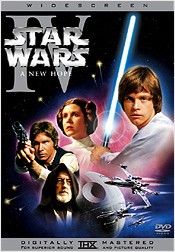
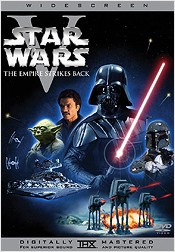
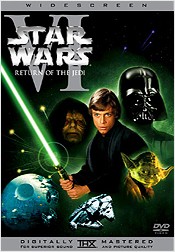
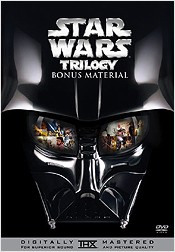
Anyone who is desperately craving copies of all of the Star Wars movies on DVD should look over the options available and think about what they want, because at this point there are good commercial copies of all six movies readily available. The discs that we have finally received from Fox prove that LucasFilm does at least provide high quality audio and video as well as some good extras, when they finally get around to releasing a title on DVD. The original trilogy's 2004 DVD release, reviewed below, makes any SE bootleg irrelevent, just as the Phantom Menace, Attack of the Clones, and Revenge of the Sith discs did in 2001, 2002, and 2005. I've retained reviews of the Phantom Menace and SE trilogy bootlegs just for the sake of amusement at this point, even though I don't recommend wasting your time on any prequel or Special Edition bootlegs. Bootleg activity continued beyond 2004, however, solely because of the changes made by Lucas to the original trilogy for the 1997 Special Edition re-release and the subsequent changes for the 2004 DVD's. Fans' desire to have a digital archive of the original theatrical versions of the trilogy led to a strong interest in bootlegs based on the 1993 or 1995 LaserDisc releases. By the time the Limited Edition discs arrived, those bootlegs had gotten surprisingly sophisticated, so I've left my reviews of those discs in place along with the reviews of the official releases. Links to each page are available below and are reproduced at the top of each review.




From the minute that the DVD format was launched in March 1997, fans started asking the question, "When is Star Wars coming out on DVD?" When September 21, 2004 arrived, the DVD format had been on the US market for almost exactly seven and a half years. Over 37,000 titles were available in Region 1. More than 76 million players had been sold in the Unites States alone. And on that day, the original Star Wars trilogy finally arrived. Why the seemingly endless delay?
First, a bit of a history lesson. The DVD format as a whole was widely predicted to be doomed in the days leading to its release. After all, LaserDisc had been around for years but had never achieved more than a niche market in the face of the massive market penetration surrounding VHS. A number of movie studios had no plans to support the format, and those that did support it often lagged behind on helping build up the format's available library of titles. The early months of the format launched seemed dangerously rocky, and Circuit City's decision to announce a competing product call DIVX mere months before DVD's first holiday season served to both offend countless "early adopter" consumers and create sufficient confusion that holiday sales were underwhelming. At the same time DVD was beginning to trickle onto store shelves, Lucasfilm was unveiling a "new and improved" version of the Star Wars films, in the form of the 1997 Special Edition theatrical re-release and home video releases later in the year on both VHS and LaserDisc – but not DVD. Eventually, the question that so many Star Wars fans asked each other made its way to Lucasfilm: "Where are DVD's of Star Wars?" The answer was underwhelming, as Lucas was planning to wait for the format to become more established and would not commit to any likely release date. Then, in 1998, Circuit City actually started selling the hardware and software for their DIVX product, and the rival format (the brainchild of an electronics superstore and a Hollywood law firm) found itself floundering amid owner confusion about the product and a ferocious Internet backlash from DVD owners. By the time DVD's second holiday season arrived, it was on its way to becoming the fastest growing new media format in history – surpassing both VHS and the compact disc. "Day and date" releases of new movies, the long-time mantra of early adopters calling for new releases to arrive on the DVD format at the same time they came out on VHS, became more and more common through 1999. DIVX died an early death, bringing an end to the brief but bitter format war as it went out with a whimper nine months after first appearing in stores. About the same time that DIVX was imploding, George Lucas released the first movie in his Star Wars prequel trilogy, Episode 1 - The Phantom Menace. The arrival of Phantom Menace brought more interest in seeing the Star Wars movies on the well-established DVD format. Now, however, Lucas began to report that he planned to wait until the entire prequel trilogy was complete to create an ultimate edition set of all six movies. This release would include further changes to the original trilogy to better tie the six movies together, and it would utilize the most modern video format, which Lucas hoped would offer true high definition resolution (an HD-DVD format, not the DVD format currently available). This release would therefore not happen until some time after Episode III arrived in theaters in mid-2005, and fans were faced with having to wait until 2006 for any of these movies to be offered on a modern format. The furor that was created by this news was compounded by a VHS release of Episode I in 2000, the simultaneous creation of a LaserDisc version of Episode I that was offered for sale in Japan but not the US, and the VHS re-release (yet again) of the Star Wars trilogy. All that furor finally led to an online petition and an open letter to George Lucas. The petition succeeded at least partially, and in June 2001 Lucasfilm announced plans to release Episode I on DVD in October 2001 (over a year and a half after the VHS release and almost two and a half years after the theatrical release). This two-disc set was a great success, although the video transfer did include some unnecessary edge enhancement. When Attack of the Clones arrived in theaters the following May, the arrival of the movie on DVD that fall was almost a certainty, but there was still something missing: the original trilogy. And it wasn't alone, as the Indiana Jones movies also remained MIA. Even after a DVD set featuring all three Indiana Jones movies was announced for release in the fall of 2003, Lucas stuck to his guns on holding the Star Wars trilogy back until 2006. He also made it clear that when the day finally came for a DVD release of the trilogy, it would not include the original theatrical releases in any form – the changes made in 1997 and any subsequent revisions represented the only official form of the movies. A second petition resulted, as a group of fans called for the preservation of the movies in their original forms. As of this writing, that petition has been unsuccessful, and all indications are that it will remain so. At the same time, however, Lucasfilm was so pleased with the success of the Indiana Jones DVD set (and so unsettled by the extensive bootleg market, according to an interview with Lucas in fall 2004) that they decided to do the same with the original trilogy, and by late 2003 the rumors were flying about a late 2004 release of a four-disc set containing all three movies plus a collection of bonus material. Those rumors became fact on February 10, 2004, when Lucasfilm and Fox officially announced the release of a four-disc DVD set of the Star Wars Trilogy on September 21, 2004.
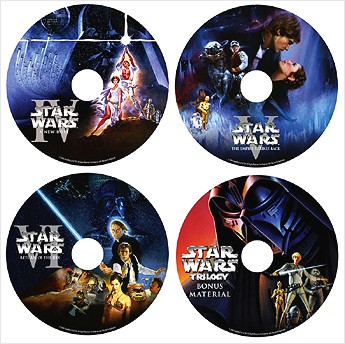
That's a lot of information just to get to the present day of late September 2004. It is now possible to go to the store and buy DVD's of the Star Wars trilogy, in either anamorphic widescreen or chopped down "full screen" pan and scan. These DVD's are based on the 1997 Special Editions, but they also include a few new revisions. They also include video transfers created by Lowry Digital, newly remixed Dolby Digital EX audio, brand new commentary tracks, and a bonus disc loaded with interesting goodies. The full specifications for the Star Wars Trilogy DVD's are:
First, the video quality. From the opening moments of A New Hope, it is clear that Lowry Digital has done some phenomenal work. The video quality is great – the flyby of the blockade runner and Star Destroyer look even cleaner and more detailed than they did in the theater in 1997. Clearly, the addition of a new progressive scan DVD player at last (less than a week before these discs arrived) to complement my HDTV was well timed, as the level of detail and clarity on the Star Destroyer's hull is a really cool way to start out the disc. The CGI revisions are still apparent to someone familiar with the original theatrical cuts, but they are much more seamless. My wife remarked about 30 minutes in to A New Hope that it all seemed to look much more like the prequels (as opposed to a movie that was nearly a quarter of a century older than the most recently released episodes). Han Solo's shootout with Greedo is still clumsy, but either the revisions, the anticipation of the change, or a combination of the two has lessened the sense of "wrongness" a little bit. Jabba's meeting with Han is still a little quirky (unavoidably, I feel, since there's only so much you can do when replacing a heavyset man with a giant slug), but it does feel somewhat less jarring. The Empire Strikes Back received the least digital doctoring in 1997 and again comes out with the fewest alterations. The handful of added and digitally altered scenes (including the use of Ian McDiarmid as the Emperor instead of the women used originally during the brief communication with Vader, which was changed for this DVD release) blend in well to complement the overall excellent video quality achieved by Lowry's new transfer. Return of the Jedi had a few notable revisions in 1997 that remain fairly well integrated (if sometimes distracting): Jabba's more spastic band, a more lively sarlacc, and victory celebrations at Bespin, Coruscant, and Tatooine. In addition, the DVD release includes some significant effects clean-up work on the Rancor (removed matte lines, making it blend in a lot better), a victory celebration at Naboo, a couple skyline changes to Coruscant's celebration, and most notably the replacement of Sebastian Shaw with Hayden Christensen as Anakin's spirit at the end. The restoration work is as good as can be imagined, even if it is strange to see Christensen in place of Shaw. All in all, the video transfers on all three discs are beautiful.
On September 30, 2004, The Digital Bits reported that some people have encountered a problem that looks to be related to a mistake in pressing some of the A New Hope discs: the disc freezes for a few seconds (apparently suspect near the layer switch point) and then skips ahead several minutes. Fox Customer Service is taking names and addresses of people affected by this problem and will be sending them a replacement disc. If this affects you, give them a call at 888-223-2FOX. It apparently only affected a limited number of discs.
Star Wars movies have always relied heavily on the audio side to help carry the story along, from Ben Burtt's sound effects to John Williams' scores to the surround sound advances that Lucas has helped push forward. As a result, fans expect a lot from the audio presentation of a Star Wars movie. As noted by The Digital Bits, there seem to be a few places in A New Hope where the score was turned down – Bill Hunt noted it at the beginning of the attack on the Death Star, and I felt like it might also be true in the first couple scenes onboard Tantive IV at the beginning of the movie. Also, some of the dialogue is still from the same recordings as before, so there were instances where it seemed a bit tinny to my ear – something that I would find odd in a new movie, but it's always been that way on this movie. Considering when it was made and what the budget was I find it sort of fitting for it to still be present. Some people have commented on the varying audio quality in Tarkin's dialogue immediately before the destruction of Alderaan, but I found that dialogue to behave similarly to a number of other sequences involving many characters (Han in the cantina springs to mind, but it occurred on a number of occasions). I suspect that this is primarily due to the "tinny" nature of the old recordings, but it also seems tied to changes in camera angle. For example, there is a difference in the way Tarkin's dialogue sounds when he is speaking one line from off-screen and when he speaks the next line directly to the camera. In the end, I found the dialogue in A New Hope to be perhaps the only weakness in the disc, due presumably to the condition of the source audio, since this condition was only apparent on A New Hope. The changes to the audio in Empire are minimal and the overall track is excellent, with clean dialogue and good effects and score. A few explosions have definitely been amped up a bit without going over the top (the Imperial probe droid's self destruction exhibits more rumble than I remember, for example), and of course Boba Fett's dialogue has been re-recorded by Temuera Morrison (Jango Fett from Attack of the Clones). I was surprised to find that while I knew it was no longer Jeremy Bulloch's voice, the change was remarkably subtle – Morrison clearly attempted to stay true to the style established by Bulloch originally, down to the last inflection, and this nod to the first Fett's work prevents the continuity-driven change from being irritating. Another interesting and well-integrated bit of continuity work also shows up on the audio for Fett's Slave I, as the ship's engine sounds (most noticeable as Slave I lights its drives and follows the Millennium Falcon away from the asteroid field) now match the sounds used in Attack of the Clones. The revamped scene with Emperor Palpatine is a bit disjointed, but not as much so as some reviews I'd read had led me to expect. McDiarmid's voice acting matches his other work as Palpatine, but some of the actual dialogue is clumsy – Palpatine clearly is presuming that Vader does not already know that the rebel pilot responsible for the destruction of the Death Star was Anakin's son, and Vader plays along even though he previously told Admiral Ozzel to move on Hoth because the rebels are there and "Skywalker is with them." While the decision to re-visit the scene using McDiarmid's face and voice makes sense from a continuity standpoint, it might have been better to leave the original script in place, but thankfully that is probably the only negative aspect of changes made for this release – the episode that many fans consider the best in the series remains the least changed from its original theatrical release. As with Empire, the audio on Return of the Jedi is excellent. A few explosions have been beefed up, but otherwise I didn't notice any changes aside from the music revisions made in 1997 (Jabba's band and the celebration music). To my ear, the audio on both Empire and Jedi is excellent; the sound on A New Hope suffers from a few problems, many of which may be due to limitations in the source material.
When Phantom Menace finally arrived on DVD in 2001, the two-disc set that hit shelves was the product of DVD producer and designer Van Ling, who was at the time just coming off of highly publicized and successful work on Terminator 2 and Abyss DVD's. Ling established the style for Star Wars DVD's with the Phantom Menace set: movie discs that offer three different randomly-selected menus based on three different worlds from the movie and well animated, easy to navigate menus. Attack of the Clones followed suit, with equally well-received results. Van Ling returned yet again to oversee the menus for this set. At least for me, the menus look a little nicer than Episodes I and II, but that's just a personal preference. They are nicely consistent with the other DVD's and very well done.
After the lengthy delay in getting Star Wars on DVD, you would hope that the release would include some really good extras. Then again, there have been plenty of slow-to-come DVD releases that finally showed up as severely bare bones discs. Lucas has been steadily collecting and archiving Star Wars material for decades, so the resources that exist are extensive – from all accounts, the new documentary "Empire of Dreams" only scratches the surface. There is a nice assortment of material here – it feels very much like an extension of the bonus material provided previously for releases like the 1993 Definitive Edition LaserDiscs, with a core of interesting featurettes (including the centerpiece documentary), an assortment of trailers and TV spots, and photo galleries. There is inevitably going to be a lot more material left out – the LucasFilm archives are large enough that you could probably create a ten-disc set full of documentaries, featurettes, old "making of" TV specials, trailers and TV ads, photo galleries, interviews, and deleted scenes given enough time. I think the only thing I would really have liked to have seen on this disc is a few deleted or alternate scenes, such as the scene with Luke and Biggs on Tatooine. Otherwise, the core content (documentary and featurettes, photo galleries, trailers, documentaries on the movie discs) is good enough and the bits of marketing fluff (video game trailer and XBox demo) minimal enough that the bonus disc stands as a very nice overall package.
As with previous Star Wars DVD's, the trilogy discs include a few easter eggs, and I'm adding them to this review at a friend's request. First, there's the standard trick to select which of the three menus you get when loading one of the movie discs: press "1", "2", or "3" during the FBI warning screen to choose which menu scheme is used. For A New Hope, "1" is Tatooine, "2" is the Death Star, and "3" is Yavin IV. For The Empire Strikes Back, "1" is Hoth, "2" is Dagobah, and "3" is Bespin. For Return of the Jedi, "1" is Tatooine, "2" is the Death Star II, and "3" is Endor. In addition to this manual control over the menus on the movie discs, there are a few goodies tucked away on the bonus disc. A Star Wars Trilogy gag reel is hidden in the "Video Game & Still Galleries" section; it can be accessed by pressing either "11" or "10+" and "1", waiting for a pause (a box next to R2-D2 will light up), then "3" followed by a pause, and then "8". There are also some outtake clips during the credits of "The Characters of Star Wars" featurette and a set of lightsaber spoof clips during the credits of "The Birth of the Lightsaber" featurette; to see these, just wait for the credits to run past.
This is a pretty important release. On the one hand, I would like to see the original versions of the movies preserved, if only to help recognize the work of the individuals who created the old effects scenes, controlled the original puppets, and otherwise worked to create the movies that I grew up with (an opinion shared – often to a much greater degree – by many fans). On the other hand, this is a great package. It is pretty impressive to me that with three movies this old and this heavily scrutinized, the only weaknesses (aside from the obvious absence of the original theatrical versions) are some dialogue thinness and curious score revisions on A New Hope and a lack of deleted scenes on the bonus disc. I still feel that it is a shame that Lucas has chosen to classify the original version of these movies as a sort of discarded rough draft, but at least he has made a strong effort to give his current vision of these movies a very good treatment on DVD. Fans who will stay away because of the changes will not be swayed by the fabulous video transfers, but when looked at independently of the issue of revisions this is a great set.
[an error occurred while processing this directive] visits since September 22, 2004